Japanese Green Tea Shops
The making of Aritayaki porcelain is a complex and time consuming process which requires skill and expertise in every step. For centuries the ceramists of Arita city in Saga prefecture Japan have been producing Aritayaki Porcelain, world renown for its superior quality and craftsmanship. Arita has been the heart of the Japanese pottery making industry for nearly 400 years.
Introduction to Aritayaki Porcelain
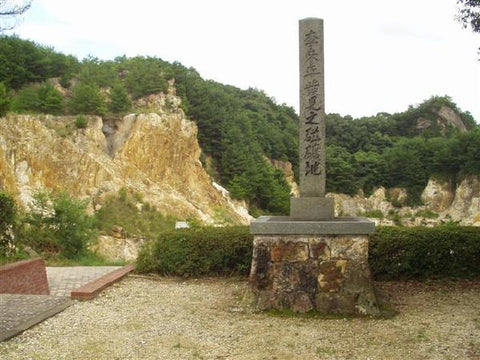
In the year 1616, A Korean ceramist named Yi Sam-pyeong , Japanese name Kanagae Sampei (金江三兵 or 金江三兵衛), discovered kaolin deposits on Izumiyama (Izumi mountain) in Arita. This discovery was essentially the beginning of the porcelain industry in Japan. For hundreds of years this mountain was where Kaolin rocks were quarried to make Aritayaki White Porcelain. Recently due to the depletion of resources and other environmental issues mining here has ceased, and today most of the kaolin comes from nearby Amakusa in Kumamoto Prefecture. Izumiyama was designated as a National Historic Landmark in 1980.
Note: The first 3 Kanji characters on this monument are 李参平 Ri -San- Pei.

Designated a National Historic Landmark in 1980.

Kaolin deposits were discovered in 1616 by Yi Sam-pyeong.

Kaolin was also mined from under the surface of Izumiyama.
Aritayaki Porcelain begins with collecting kaolin rocks and crushing them with a machine called a "stamper". The stamping turns the rocks into a fine powder which is mixed with water, and filtered through a very fine mesh screen to remove unwanted impurities. Finally, the extra water used for filtering is removed by a process called "pressing", and the resulting clay produced is the basis for all aritayaki pottery.
The Making of Aritayaki Porcelain
The actual making of the pottery pieces begins by kneading the kaolin clay to remove any air bubbles that may cause warping or cracking when fired in the kiln. It is often the practice of the ceramist to knead the clay for each piece by hand, (much the same as when the Japanese Soba master diligently kneads his dough, and equally as impressive). In the case of making Aritayaki pottery, a potter's wheel or lathe is usually used to form the piece.

Most Aritayaki is formed on the potter's wheel or lathe.

Forming is done with the hands, finer detailing with various tools. The ceramist uses a variety of tools to finish the piece.
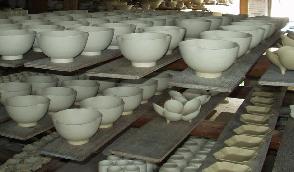
Finished articles are dried slowly on racks or boards to prevent cracking and shrinking.
The next steps are among the most important for the aritayaki ceramist, as this is when the uniqueness of each article is accomplished. The articles are allowed to sit for a short time until they are firm enough to perform the body decorating. This is when holes and lines are carved, and handles, knobs and other decorative pieces are fused to the body. While the works are still pliable they are hand trimmed and pared, until finally the finishing touches are completed. The articles are then wiped with a very fine textured damp cloth to make the surfaces as smooth as possible, and neatly placed on boards or racks to dry.
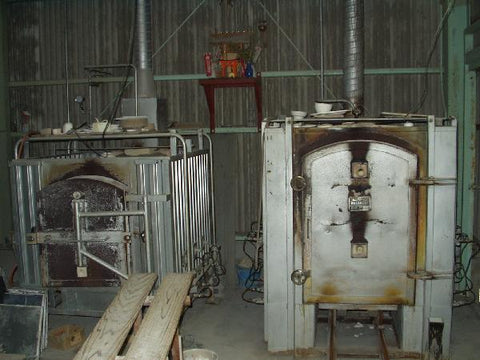
Kilns used to low fire aritayaki porcelain at temperatures of 850 to 950 degrees.
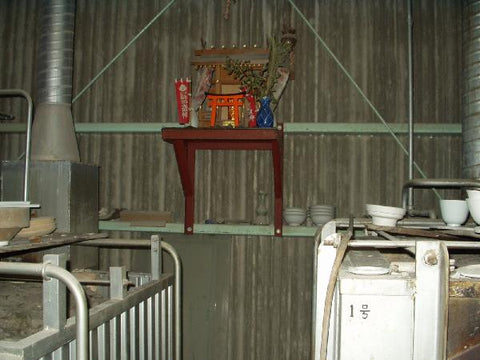
Yi Sam-pyeong is honored in the Shinto shrine as the father of Japanese porcelain.
After allowing sufficient drying time the items become hard to the touch and are ready to be low-fired. Depending on the size and thickness of the pieces, low-firing will usually be done at temperatures ranging from 850 to 950 degrees celsius. Sudden high heat can cause cracking and damage, so the kilns are heated very slowly. Time and temperature is carefully monitored during this process. When low-firing is completed, the items are removed and inspected. The experienced ceramist is able to find small defects by sight and touch, and by gentle tapping can even detect the slightest imperfections of the internal integrity by sound.
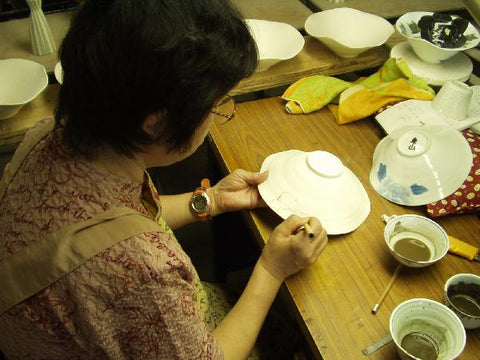
Outlining is done by hand using a paint brush.

Outlines are painted with a formula called Gosu.

Outlining and shading techniques are called "dami".
The items are now ready for the steps that will be taken by the porcelain painters. First, two types of underglaze formulas called "gosu" are prepared for outline drawing and shading. The main ingredient is cobalt which turns blue when fired in high heat, (the signature color of "Sometsuke") and is applied with various sized brushes. The outlining and shading technique is called "dami".
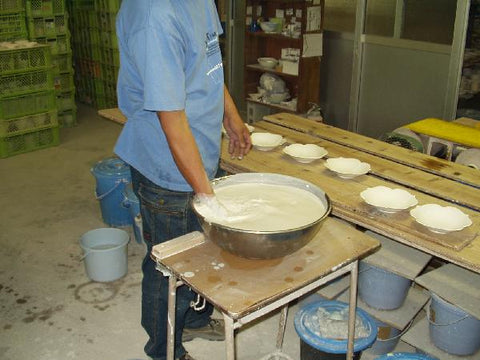
The "glass- like" thin film surface, or glaze is applied.
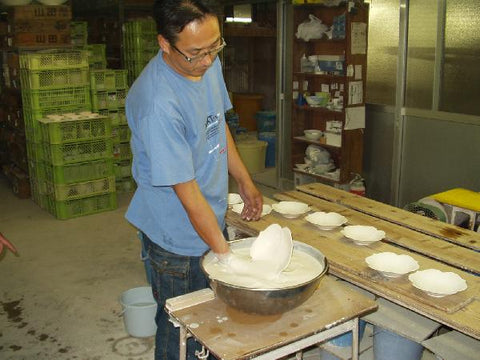
Small items are hand dipped in a glaze tank.

The pieces are allowed time to set before high firing.
Next the "glass- like" thin film surface, or glaze is applied. Most of the aritayaki kilns have a special mixture which makes their porcelain unique from the other's, (and are carefully guarded secrets). The basic formula includes silica, fedspar and limestone. The articles are immersed in a glaze tank by hand, although glaze is poured on to larger items using a dipper. The items are allowed to "set" and then the bottom surfaces are wiped so that the pieces won't adhere to the special plates used in the kiln.

Glazed aritayaki in placed in the Kiln for high firing.

High-firing is done is three basic phases.
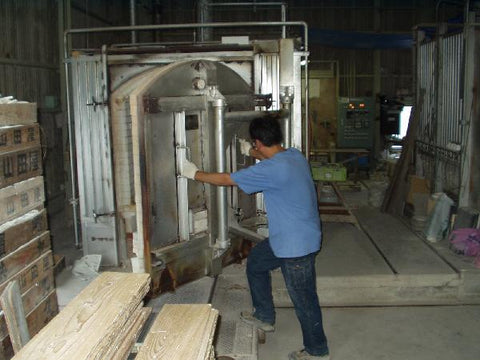
During high firing temperatures reach in excess of 1,300 degrees.
After the glaze has set, the surfaces are inspected to make sure they are smooth. The items are neatly placed on special racks to allow adequate dispersion of heat, and then are loaded into the kiln.
The glazed articles are now ready to be High-fired. As with low-firing, careful attention in payed to the firing time and temperature of the kiln. The high-firing technique is done in three basic phases. First, the kiln is slowly heated to about 900 degrees. Secondly, the heat is quickly raised to around 1,200 degrees and finally, temperature is allowed to reach in excess of 1,300 degrees. This is the point at which the clay and glaze are matured into porcelainized pottery.
The types of aritayaki called "Hakuji" (white porcelain), "Seji" (or Celadon Porcelain-pale blue green in color), "Ruri" (Dark blue cobalt glazed porcelain) and "Sometsuke" (white porcelain decorated with blue cobalt designs) are now complete, however, a final step of "over glazing" is required for some other styles like "akae", "iroe" and "somenishiki" porcelain.
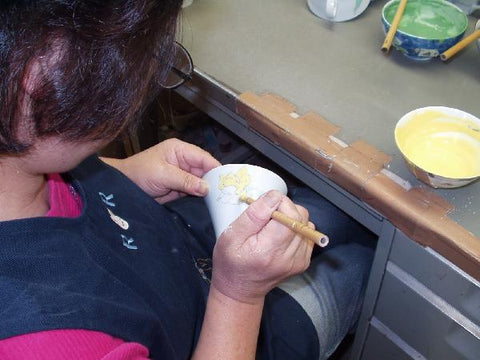
Dami techniques are used for shading and drawing with the mixed over glaze.
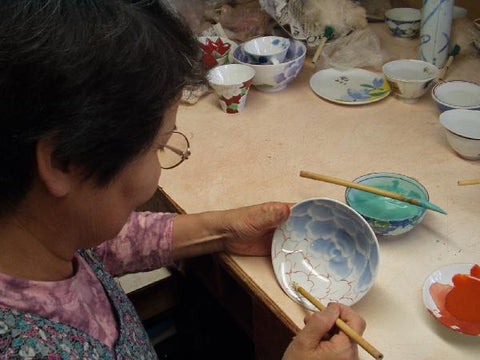
Colors such as yellow, red, green, black, silver and gold are hand painted.
As with under glazing, "dami" techniques are used for shading and drawing with the mixed over glaze in colors such as yellow, red, green, black, silver and gold.

Over glazed porcelain items are placed in a kiln and low fired.

Low firing is done at temperatures ranging from 700 to 850 degrees.
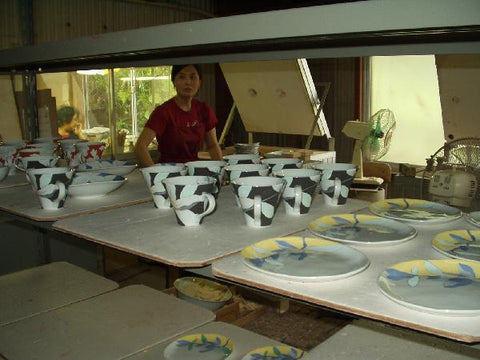
The Making of Aritayaki Porcelain is completed.
Finally, the painted porcelain items are placed in a kiln and low fired again at temperatures ranging from 700 to 850 degrees (celsius) to fuse the over glaze to the surface. The items are then carefully removed and inspected. The Making of Aritayaki is completed.